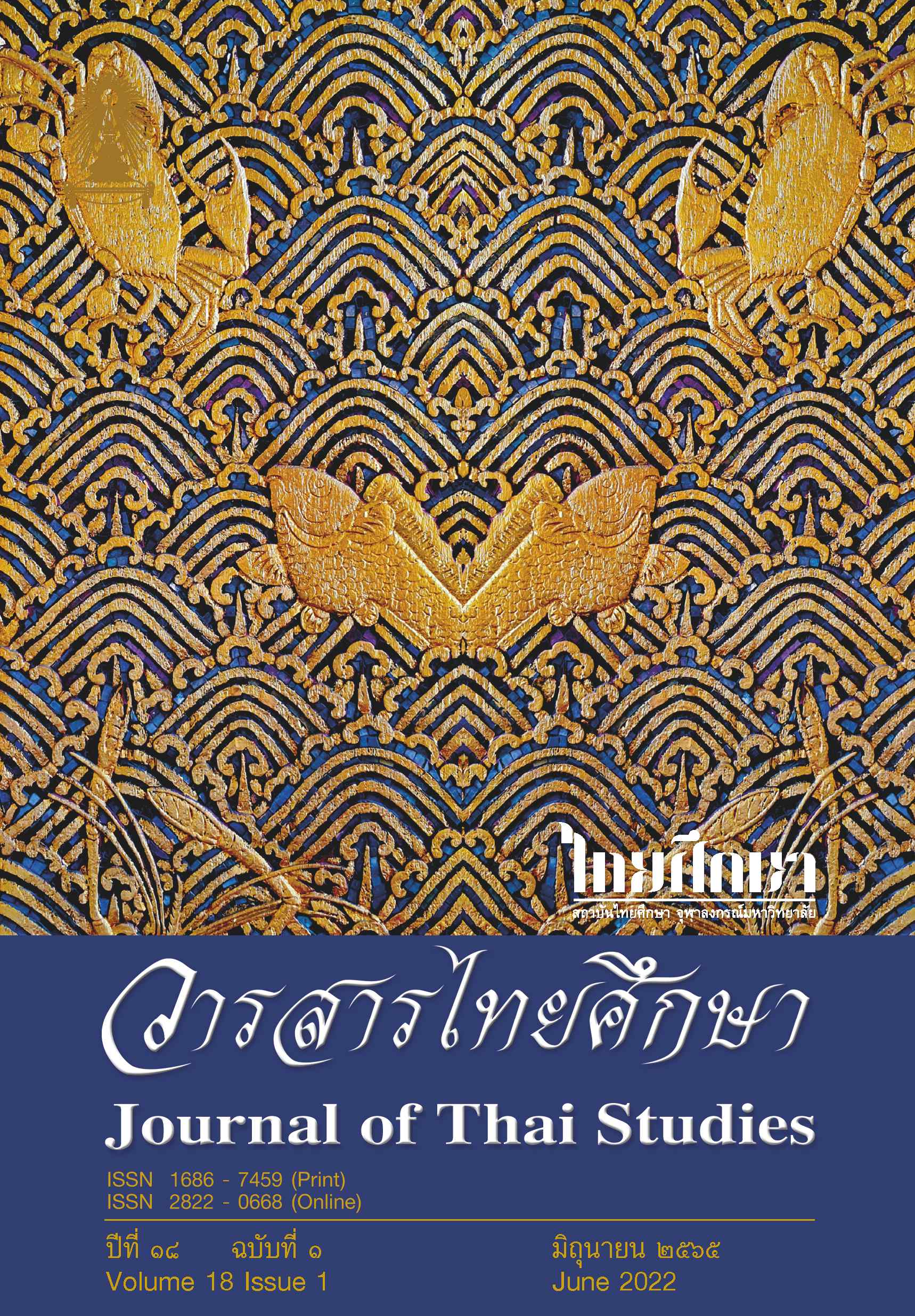อุปลักษณ์เชิงมโนทัศน์ของคำเรียกสิ่งของเครื่องใช้ในภาษาไทพวน
Main Article Content
บทคัดย่อ
บทความนี้มีวัตถุประสงค์เพื่อศึกษาถ้อยคำอุปลักษณ์และวิเคราะห์อุปลักษณ์เชิงมโนทัศน์จากคำเรียกสิ่งของเครื่องใช้ในภาษาไทพวนตามแนวคิดทฤษฎีภาษาศาสตร์ปริชาน โดยศึกษาจากรายการสิ่งของเครื่องใช้พื้นบ้านของชาวไทพวนตำบลหาดเสี้ยวอำเภอศรีสัชนาลัย จังหวัดสุโขทัย
ผลการศึกษาพบว่ามีการขยายความหมายแบบอุปลักษณ์เชิงมโนทัศน์คิดเป็นร้อยละ 35.71 สามารถจัดหมวดหมู่ความหมายได้เป็น 10 ประเภท เป็นการถ่ายโยงความหมายแบบภวสัมพันธ์ จำนวน 4 ประเภท ได้แก่ อุปลักษณ์ผู้หญิงอุปลักษณ์อาการของมนุษย์ อุปลักษณ์สัตว์ และอุปลักษณ์วัตถุ (ต่างวงความหมาย) และการถ่ายโยงความหมายแบบญาณสัมพันธ์ จำนวน 6 ประเภท ได้แก่ อุปลักษณ์วัตถุ + อาการของมนุษย์ อุปลักษณ์วัตถุ + อวัยวะของมนุษย์ อุปลักษณ์วัตถุ + สภาพของมนุษย์ อุปลักษณ์อาการของมนุษย์ + วัตถุ อุปลักษณ์สัตว์ + อาการของมนุษย์ และอุปลักษณ์ที่อาศัยของมนุษย์ + วัตถุ
Article Details

This work is licensed under a Creative Commons Attribution-NonCommercial-NoDerivatives 4.0 International License.
วารสารไทยศึกษาอยู่ภายใต้การอนุญาต Creative Commons Attribution-Noncommercial-NoDerivatives4.0 Intenational (CC BY-NC-ND 4.0) เว้นแต่จะระบุไว้เป็นอย่างอื่น โปรดอ่านหน้านโยบายของเราสำหรับข้อมูลเพิ่มเติมเกี่ยวกับการเข้าถึงแบบเปิด ลิขสิทธิ์ และการอนุญาต
References
Akharawatthanakun, P. (2019). “Phuan” is not “Lao”: Linguistic Evidence in Lexical and Phonological Aspects Confirming Language Distinction. Humanities & Social Sciences, 36(1), 1-31.
Department of Cultural Promotion. (2016). phasa: moradok phumpanya thang watthanatham khong chat. [Language: National Intangible Cultural Heritage]. Bangkok: The War Veterans Organization of Thailand Under Royal Patronage of His majesty the King.
Evans, V., & Green, M. (2006). Cognitive linguistics: An introduction. Edinburgh: Edinburgh University Press.
Homduang, S. & Buakaw, S. (2016). Consonant Variation in Thai Phuan Spoken at Ban Phue District, Udon Thani Province. Journal of Graduate Study in Humanities and Social Sciences, 5(1), 122-137.
Jaimaitee, T. & Sungkaman, U. (2016). A Study of the Lexical Variation in Phuan Language of Ban Mi District, Lop Buri Province. Academic Journal of Humanities and Social Sciences, 24(45), 245-262.
Jirananthanaporn, S. (1993). rai-ngan kan wichai rueang wongchon sap nai watthanatham kan tho pha khong thai phuan. [A study of words used in the process of Thai Phuan Traditional Weaving]. Phitsanulok: Naresuan University, Thailand.
Jirananthanaporn, S., Singnoi, U. & Chinakkhrapong, O. (2008). rai-ngan wichai chabap sombun thatsanakhati thang phasa khong klum chattiphan thai thi mi to phasa khong ton-eng nai khet phaknuea ton lang. [Language Attitudes of Tai Ethnic Groups toward their Language in the Lower Northern Part of Thailand]. Phitsanulok: Naresuan University, Thailand.
Khemmuk, Y. et al. (2015). photchananukrom phasa thai phuan. [Dictionary of Thai-Phuan Language]. Chiang Mai: Chiang Mai Rajabhat University.
Kövecses, Z. (2005). Metaphor in culture: Universality and variation. Cambridge: Cambridge University Press.
Kövecses, Z. (2010). Metaphor: A Practical Introduction. (2nd ed.). Oxford: Oxford University Press.
Lakoff, G. (1987). Women, Fire, and Dangerous Things: What categories reveal about the mind. Chicago and London: The University of Chicago Press.
Lakoff, G. and Johnson, M. (1980). Metaphor We Live By. Chicago and London: The University of Chicago Press.
Office of the Royal Society. (2013). photchananukrom chabap ratchabandittayasathan phoso 2554. [Dictionary of the Office of the Royal Institute, B.E.2554]. Bangkok: Office of the Royal Society.
Panichakul, P. (2004). An ethnosemantic study of names and the system of making traditional Sin-Mudmee of the Tai Phuan in Amphoe Ban Mi, Changwat Lop Buri. (Master’s degree thesis). Chulalongkorn University, Bangkok, Thailand.
Phongphiriyawanit, K. (2016). A Study of Personal Pronouns in Isan Thai-Phuan: Language changes and usage. In The 12th International Conference on Humanities and Social Sciences) IC-HUSO 2016 in November 14-15, p. 2139-2155. Khon Kaen: Khon Kaen University.
Premsrirat, S. et al. (2004). phaenthi phasa khong klum chattiphan tang tang nai prathet thai. [Ethnolinguistic maps of Thailand]. Bangkok: Department of Cultural Promotion.
Singsawat, P. (2018). The Status of Phuan Language Studies. Chophayom Journal, 29(1), 475-486.
Singsena, N. & Benjathikul, C. (2015). The Personal Pronoun of Thai-Phuan in Isan Region. Journal of Graduate Study in Humanities and Social Sciences, 4(1), 67-88.
Tawichai, S. (2006). Conceptual Metaphors of Anger in Thai. (Master’s degree thesis). Silpakorn University, Bangkok, Thailand.
Tawichai, S. (2018). The Status of Research on Conceptual Metaphors in Thai. Journal of the Faculty of Arts, Silpakorn University, 40(2), 202-254.
Thai Phuan Foundation. (1989). photchananukrom phasa thai phuan. [Dictionary of Thai-Phuan Language]. Bangkok: Aksornbundit.
Wongthai, N. (2019). at sat pari chan bueangton. [The Basics of Semantics]. Bangkok: Work all print company Limited.
Wongwattana, U. S. (2014). kham riak chue phuet baep phuenban thai: kansueksa choeng phasasat phrueksasat chattiphan. [Thai folk plant names: a study in ethno-botanical linguistics]. Bangkok: Chulalongkorn University Press.
Wongwattana, U. S. (2020). System of Auto-part Terms in Thai in the View of Cognitive Linguistics. Journal of Humanities, Naresuan University, 17(3), 31-48.

